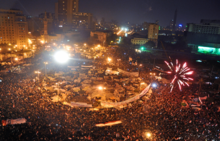Media activism
Although often only a small percentage of people who express interest in a cause online are willing to commit to offline action, social media interaction is viewed as "the first step in a ladder of engagement".
[9]"Social media has helped us organize without having leaders," said Victor Damaso, 22, demonstrating on São Paulo's main Paulista Avenue on Thursday night.
Media Activists in China used their online presence and freedom to alter images, such as Marilyn Monroe, to have the face of Chinese Communist leader Mao Zedong.
"Maorilyn Maoroe" was an opponent to the societal River Crab, which is a pun on "harmonious," a principle that Chinese censorship was created to promote, but has failed to do so.
[22] In China, youth and other media activists have discovered and utilized new methods to indirectly criticize the political and societal environments, going around the government censorship.
These nations concentrated on the ability of the society to operate social media and begin organizing a grassroots initiative for a globalized form of democracy.
[25] Egyptian protesters utilized social media to reduce the difficulties and cost associated with organizing rallies and a readily-mobilized political force.
[26] This facilitation of assembly through social media allowed the creation of new gateways for civic engagement where Egypt had suppressed such opportunities under emergency power for the last 30 years.
[24] The Philippines was once said to have the freest press in Southeast Asia, after the ousting of Ferdinand Marcos, due to the subsequent rapid expansion of newspapers, radio stations, and programming throughout the country.
[29] In 2010, Mary Jane Veloso, an overseas Filipino domestic worker, was arrested and convicted in Indonesia for attempting to smuggle 5.7lb of heroin.
[32] Media activism has a long history in the United States including the revolutionary pamphleteers of the Revolutionary War, the abolitionist press in the decades leading up to the Civil War and the socialist press during the years of the labor movement such as The Appeal to Reason which supported the presidential candidate Eugene Debs.
[33] The Occupy Wall Street movement, which began during the fall of 2011, is another instance were social media largely contributed to the efforts of the initiative.
The occupy protests helped to motivate workers in the fast food industry in New York City to walk off their jobs in November, 2012, triggering national movement to raise the minimum wage to $15 an hour.
The hashtag #blacklivesmatter was created in 2013 by Patrisse Cullors, Alicia Garza, and Opal Tometi after the acquittal of George Zimmerman for the murder in Florida of seventeen-year-old Trayvon Martin.
This movement began in 2013 when people started hash tagging #BLM, #BlackLivesMatter, and #equality on Twitter, Facebook, and many social media platforms.
[37] Hashtags such as #OscarsSoWhite, #handsupdontshoot, and #icantbreathe have sprung up as offshoots in the social movement and have helped create a subculture on the website that some have called "Black Twitter".
[39] Citizen reporting on platforms such as Twitter and Facebook help drive the coverage of traditional media on stories of violence, discrimination, and harassment.
[42] The challenge picked up a mass following due to the amount of lives touched by the disease and the desire to see progress in the fight against ALS.
He was accused of abducting over 60,000 Ugandan children, turning the boys into brainwashed killing machines and the young girls into sex slaves.
Things like online distribution, podcasts and the new cultural norm of social media have been fused with the traditional rallies, protests and lobbying efforts and have created a new type of change that is somewhat convenient for its followers.
[45] These new social platforms have made it possible for the public to be both the consumer and producer of media, making their efforts for change reach numbers of people at never before seen speed, like the Kony video.
[48] On Sunday November 20, 2016, livestreams and videos were circulated through social media platforms that showed evidence of North Dakota law enforcement officers utilizing "pepper spray, teargas, rubber bullets, Tasers, sound weapons, and other "less-than-lethal" weapons"[49] against pipeline protestors[50] who referred to themselves as Water Protectors.
[51] On March 14, 2013, Lourdes Alicia Ortega Pérez was imprisoned by the Scientific Penal and Criminal Investigation Corps of Venezuela for tweeting a message that was considered "destabilizing to the country".
Through the usage of media technology and online communication, Indigenous groups are able to reach out further than their specific localities and build solidarity with other national minorities who face similar issues.
[29] Agents of media in terms of activism, are a doubled edged sword which indicate the historic importance, while also laying stepping stones for its significance in the future.
[59] In a comprehensive study of Aboriginal and Torres Strait Islander social media use, Bronwyn Carlson and Ryan Frazer found that many people experience unpleasant interactions like trolling and racism, but still value social media: "For many, it had become an invaluable tool in the realisation of their hopes and dreams; it helped them 'find' and share their identities and produce intimate communities of mutual trust, respect, care and kindness.
[56] Dominant elites, or those challenged by media activism, have tried to push back by filtering the internet, blocking specific websites, decreasing the connection speeds, and tracking users who view political information.
The Chinese state engages in media censorship in the name of national harmony, although the Council on Foreign Relations argues that suppression of online activism is to protect authorities' political or economic interests.
Slacktivism is a term coined to emphasize on the lack of action media activism enrolls, through engaging in the talk of social issues but not reacting.
[63] Critics argue that media activism does not seem to be the most efficient engine in taking action towards social regimes, however many recognize it as a powerful tool of communication to connect like-minded populations.


